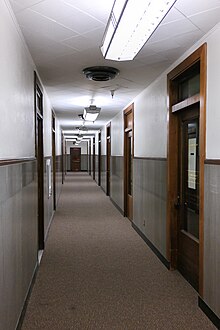Hallway
SUBTOPIC: References
– Collins Dictionary
– Mitton, Maureen; Nystuen, Courtney (11 January 2011). Residential Interior Design: A Guide to Planning Spaces. John Wiley & Sons. p.201. ISBN978-1-118-04602-9
– Guideline for Square Footage Requirements for Educational Facilities (PDF). Georgia Department of Education. Retrieved 10 March 2021
– Carson, Chip. The Life Safety Code and health care corridor width. www.nfpa.org. Retrieved 10 March 2021
– Judith Flanders (8 September 2015). The Making of Home: The 500-Year Story of How Our Houses Became Our Homes. St. Martins Press. ISBN978-1-4668-7548-7
SUBTOPIC: Corridor Width Requirements
– Minimum clear width of corridors: 8 feet for 2 or more IUs
– Corridors with lockers on one side: minimum clear width of 9 feet
– Corridors with lockers on both sides: minimum width of 10 feet
– NFPA 101® requires new health care facilities to have 8 feet wide corridors
– Compliance with Life Safety Code® is crucial for corridor width in health care facilities
SUBTOPIC: Educational Facility Guidelines
– Educational facilities have specific square footage requirements
– Guidelines for square footage are provided by the Georgia Department of Education
– Compliance with square footage guidelines is essential for planning educational spaces
– Proper planning ensures efficient use of space in educational facilities
– Square footage requirements contribute to the safety and functionality of educational spaces
SUBTOPIC: Impact of Locker Placement
– Locker placement affects corridor width requirements
– Corridors with lockers on one side require wider clear width
– Lockers on both sides necessitate even wider corridors
– Proper planning of locker placement is essential for efficient space utilization
– Compliance with corridor width regulations ensures safe passage in educational and health care facilities
SUBTOPIC: Evolution of Home Design
– The evolution of houses into homes spans 500 years
– Understanding the history of home design provides insights into modern living spaces
– Judith Flanders’ book explores the transformation of houses into personal sanctuaries
– The Making of Home offers a historical perspective on the concept of home
– Historical context enriches our understanding of residential interior design
A hallway, passage, passageway or corridor is an interior space in a building that is used to connect other rooms. Hallways are generally long and narrow.


Hallways must be sufficiently wide to ensure buildings can be evacuated during a fire, and to allow people in wheelchairs to navigate them. The minimum width of a hallway is governed by building codes. Minimum widths in residences are 36 inches (910 mm) in the United States. Hallways are wider in higher-traffic settings, such as schools and hospitals.
In 1597 John Thorpe is the first recorded architect to replace multiple connected rooms with rooms along a corridor each accessed by a separate door.
